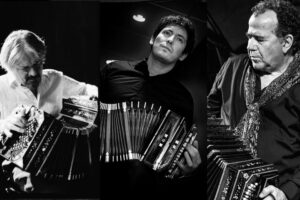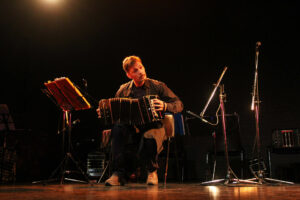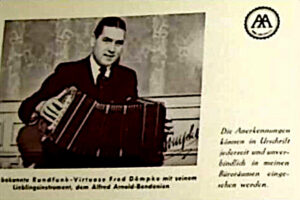
Bandoneón Tutorial: The Inicial 1
In this bandoneón tutorial I explain the first of a series of preparatory exercises. After having dedicated a series of videos to the fundamental aspects
This article is not an apology for Nazism nor an indictment of Germany’s past.
It’s just the history of bandoneon during a specific period of Germany: It is based on historical evidence and public documents, and should be considered as a historical and informative report.
If you play the bandoneon, your instrument was probably built in Germany during Nazi era. I know that this information generally doesn’t constitute a moral issue: the incredible sound of those vintage instruments makes you forget about it. However it always impressed me that, if you play an old bandoneon, you’re handling an authentic piece of History, and I think it’s something worth investigating.
This research is divided into three parts: bandoneon genesis, during Nazi era (between 1933 and 1945) and after WW2 (from 1945 until the early 1950s).
There’s plenty of information on the web regarding the history of the bandoneon, so I will only make a brief introduction. The bandoneon has as its ancestor the German concertina (or Konzertina), invented by Carl Uhlig in the mid-19th century inspired by the English concertina.

The instrument was successful in the context of popular music, similarly to the other concertinas, the “organetto” (Italian diatonic accordion) and the various types of accordions and “harmonikas”. In the wake of this success, various others manufacturers in Germany started to produce and market these instruments. One of them was Heinrich Band who made some changes to the keyboard and commercialized the bandonion on a large scale, giving his surname to the instrument and adding the suffix “onion” in analogy with the already existing accordion.

A little consideration: the bandoneon was not born or used to replace the pipe organ. For that purpose the harmonium was good enough: it was versatile, relatively economic and quite transportable. Any pianist or organist was able to play it, unlike concertina or bandoneon which required a specific training and were much more limited in tone and range of notes. It is a legend devoid of any historical evidence, but still widespread among bandoneon players.
At this point the family splits: on the one hand there were the instruments of Heinrich Band, which will arrive in the Rio de la Plata area and will become the typical tango bandoneon: the 142 aka Rheinische Tonlage.
On the other hand, concertina production will continue with what was called Chemnitzer Konzertina and also with a new bandoneon layout, the model 144 aka Einheits Tonlage, created to unify the dozens and dozens of bandoneon keyboards present at the time (there are those who speak of more than 60 different keyboards). This was in 1924.
Bandoneon and concertina in those years were quite common in Germany, Holland, Belgium, and partly in France, Poland and Bohemia. Bandoneon orchestras were born, as well as bandoneon players associations. To limit the spread of non-standard keyboards, In Germany models other than 144 were prohibited from playing in the orchestras.

Meanwhile, the crisis of ’29 and the advent of Nazism arrived (in 1933).
The Nazi exalted martial and triumphal music, and there was not a good consideration for reed instruments’ melodious and melancholic sound; rather, broad emphasis on marches, fanfares and orchestras playing powerful overtures.

But this was probably just an excuse.
The reality is that Nazism feared the influence of many cultural associations (which often were more social than recreational) and in 1935 many of these institutions were banned, including those of bandoneon players.
To better understand the situation, an interesting document comes in handy: “Das Doppelte A: von bandonion zum bandoneon” (The doble A: from bandonion to bandoneón – A/N) by Rolf Lambert available in German here.
I translate from German the text that appears on page 5, third column.
The association is based on the labor movement, says the statute of the Bandonion-Dachverband (Organization of Bandoneon) of 1911.
On February 2, 1935, most of the bandonion associations were dissolved and banned by the National Socialist Reichsmusikkammer.
The Nazis considered reed instruments unsuitable for people’s music: according to them, the sound was too shrill.
The various musical associations didn’t just play overtures, marches and polkas at events and dances, but also German workers political songs. Here’s what the conductor Alfred Just says in the chronicle annals of “1. Stuttgarter Bandonion-Verein Freildang 1901”:
We played in the Dinckelacker hall the night before Hitler’s rally, at a crowded rally of the Anti-Fascist Militant League. We listened for the last time the workers’ songs and other revolutionary music, accompanied by our orchestra.
The association had already destroyed all the documents in 1933, so that they would not fall in the hands of the Gestapo. Proletarian music scores were soaked with water, then balled up and compressed into paper briquettes. House searches and Gestapo interrogations were frequent.
More and more members stayed away from the rehearsals.After the War
The difficult situation of bandoneon factories
The text continues by recounting the difficult situation of the German bandoneon factories in the last stages of the conflict and giving ideas for interpretation on why the quality of the instruments dropped dramatically during and especially after the war.
We sold Bandonions for pounds of potatoes […] Helmut Fleischer succinctly describes the need after the end of the war.
During the Second World War the production of non-war industries was stopped in Carlsfeld. Many of the workers were drafted into the Wehrmacht. Some did not come back, some only later from captivity.
The production of the instruments slowly resumes due to the continuous power outages, it is difficult to find zinc and aluminum for the production of the plates.
A certain amount of stock was still there. There was wood and a few more purchased parts.
A bell calls you to work when electricity is back.Fleischer says the area was initially under American control, but then the Russians came. After all, Carlsfeld was in the Soviet sector.

In 1949 the DDR administration decided to convert the AA in a factory for the production of parts for diesel engines. Lacking the world’s main production center of bandoneon, the instrument’s inexorable decline began. This process was worsened by the lack of interest in tango, and in general in “melodic” music, for the benefit of nascent rock in the 60s.
In the meantime, some small artisanal poles survived in Germany and storically perpetuated the production (albeit limited to a few instruments per year), and then these experienced masters taught the new generations of talented European bandoneon makers, who started brand new bandoneons production in the 80s and 90s.
I’d like to thank Mr. Eric Gerritsen who inspired me to create this article, introduced me to some of the sources and translated them from German.

In this bandoneón tutorial I explain the first of a series of preparatory exercises. After having dedicated a series of videos to the fundamental aspects

Learn about chromatic bandoneons! Download FREE PDF keyboard layouts for Peguri, Manoury, & Crosio-Caliero systems. Unisonoric bandoneon explained for beginners.

A Lesson from the Bandoneon to Move from Stage Panic to Expressiveness 2024 is coming to an end and I have been very busy during

Who is Fred Dömpke and why should deserve more consideration among the bandoneon players? The bandoneon is conquering a significant role in jazz. Many bandoneon

The Bandoneon Price depends on the type of Bandoneon you want to buy. The equation is simple: if you want to learn to play the

Discussing Bandoneon Making with Baltazar Estol A few years ago I saw a video by M. Rodolfo Daluisio playing a bandoneon built by Baltazar Estol.
3 Comments
https://encyclopedia.ushmm.org/content/en/article/auschwitz-through-the-lens-of-the-ss-the-album
See SS social gathering. An Bandoneon is layed for Auschwitz commander and his prominent guests. Explain this to the people who hold the myth that it was an instrument of the political left! Was it played and liked under Mussolini’s rule as it was under military dictatorship in Argentina? Let’s be careful with myths … All the best from Oldenburg in Germany, Christian Hauck-Hahmann
Dear Christian, thank you for your comment. The idea behind this post was not to defend the instrument as belonging to a certain political stance or point of view, but to broaden the understanding of its history, especially in Germany in the past, as little information has survived or been written about it. There is probably a lot of literature about it in German, but I can’t read German (for the moment 🙂 So your comment is very useful for those who, like me, would like to deepen their understanding of the history of the bandonion. Thank you very much.
Best regards.
Let me give you a recommendation to translate online: Post German or other text at Deepl.com and translate it highly accurately.